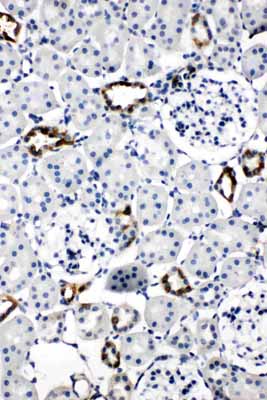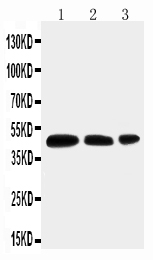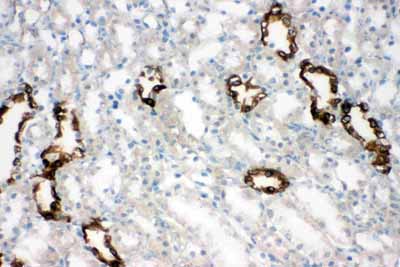Anti-Aquaporin 2 Antibody
- SPECIFICATION
- CITATIONS
- PROTOCOLS
- BACKGROUND

Application
| WB, IHC-P, IHC-F |
|---|---|
| Primary Accession | P41181 |
| Host | Rabbit |
| Reactivity | Human, Mouse, Rat |
| Clonality | Polyclonal |
| Format | Lyophilized |
| Description | Rabbit IgG polyclonal antibody for Aquaporin-2(AQP2) detection. Tested with WB, IHC-P, IHC-F in Human;Mouse;Rat. |
| Reconstitution | Add 0.2ml of distilled water will yield a concentration of 500ug/ml. |
| Gene ID | 359 |
|---|---|
| Other Names | Aquaporin-2, AQP-2, ADH water channel, Aquaporin-CD, AQP-CD, Collecting duct water channel protein, WCH-CD, Water channel protein for renal collecting duct, AQP2 |
| Calculated MW | 28837 MW KDa |
| Application Details | Immunohistochemistry(Frozen Section), 0.5-1 µg/ml, Rat, Human, Mouse Immunohistochemistry(Paraffin-embedded Section), 0.5-1 µg/ml, Rat, Human, Mouse, By Heat Western blot, 0.1-0.5 µg/ml, Human, Mouse, Rat |
| Subcellular Localization | Apical cell membrane ; Multi-pass membrane protein . Basolateral cell membrane ; Multi-pass membrane protein . Cytoplasmic vesicle membrane ; Multi- pass membrane protein . Golgi apparatus, trans-Golgi network membrane ; Multi-pass membrane protein . Shuttles from vesicles to the apical membrane. Vasopressin-regulated phosphorylation is required for translocation to the apical cell membrane. PLEKHA8/FAPP2 is required to transport AQP2 from the TGN to sites where AQP2 is phosphorylated. |
| Tissue Specificity | Expressed in renal collecting tubules. |
| Protein Name | Aquaporin-2(AQP-2) |
| Contents | Each vial contains 5mg BSA, 0.9mg NaCl, 0.2mg Na2HPO4, 0.05mg Thimerosal, 0.05mg NaN3. |
| Immunogen | A synthetic peptide corresponding to a sequence at the C-terminus of human Aquaporin 2(245-260aa DWEEREVRRRQSVELH), identical to the related rat and mouse sequences. |
| Purification | Immunogen affinity purified. |
| Cross Reactivity | No cross reactivity with other proteins |
| Storage | At -20˚C for one year. After r˚Constitution, at 4˚C for one month. It˚Can also be aliquotted and stored frozen at -20˚C for a longer time.Avoid repeated freezing and thawing. |
| Sequence Similarities | Belongs to the MIP/aquaporin (TC 1.A.8) family. |
| Name | AQP2 |
|---|---|
| Function | Forms a water-specific channel that provides the plasma membranes of renal collecting duct with high permeability to water, thereby permitting water to move in the direction of an osmotic gradient (PubMed:8140421, PubMed:7524315, PubMed:7510718, PubMed:15509592). Plays an essential role in renal water homeostasis (PubMed:8140421, PubMed:7524315, PubMed:15509592). |
| Cellular Location | Apical cell membrane; Multi-pass membrane protein. Basolateral cell membrane {ECO:0000250|UniProtKB:P34080}; Multi-pass membrane protein. Cell membrane; Multi-pass membrane protein. Cytoplasmic vesicle membrane; Multi-pass membrane protein. Golgi apparatus, trans-Golgi network membrane; Multi-pass membrane protein Note=Shuttles from vesicles to the apical membrane (PubMed:15509592) Vasopressin-regulated phosphorylation is required for translocation to the apical cell membrane (PubMed:15509592). PLEKHA8/FAPP2 is required to transport AQP2 from the TGN to sites where AQP2 is phosphorylated (By similarity). {ECO:0000250|UniProtKB:P34080, ECO:0000269|PubMed:15509592} |
| Tissue Location | Expressed in collecting tubules in kidney medulla (at protein level) (PubMed:7510718). Detected in kidney (PubMed:7510718). |

Thousands of laboratories across the world have published research that depended on the performance of antibodies from Abcepta to advance their research. Check out links to articles that cite our products in major peer-reviewed journals, organized by research category.
info@abcepta.com, and receive a free "I Love Antibodies" mug.
Provided below are standard protocols that you may find useful for product applications.
Background
AQP2(Aquaporin 2) also called AQUAPORIN-CD, is found in the apical cell membranes of the kidney's collecting duct principal cells and in intracellular vesicles located throughout the cell. The AQP2 gene is mapped to chromosome 12q13, very close to the site of major intrinsic protein by situ hybridization. The investigators suggested that a defect in the AQP2 gene is the basis of the autosomal form of nephrogenic diabetes insipidus. The functional expression and the limited localization suggested that AQP2 is the vasopressin-regulated water channel. Using rat kidney slices and porcine kidney cells stably expressing rat Aqp2, AQP2 trafficking can be stimulated by cAMP-independent pathways that utilize nitric oxide(NO). The NO donors sodium nitroprusside(SNP) and NONOate and the NO synthase substrate L-arginine mimicked the effect of vasopressin(VP), stimulating relocation of Aqp2 from cytoplasmic vesicles to the apical plasma membrane. SNP increased intracellular cGMP rather than cAMP, and exogenous cGMP stimulated AQP2 membrane insertion. Atrial natriuretic factor, which signals via cGMP, also stimulated AQP2 translocation. AQP2 expression in kidney connecting tubules is sufficient for survival and that AQP2 expression in collecting ducts is required to regulate body water balance. The S256L substitution in the cytoplasmic tail of the Aqp2 protein prevented phosphorylation at S256 and the subsequent accumulation of Aqp2 on the apical membrane of the collecting duct principal cells.
If you have used an Abcepta product and would like to share how it has performed, please click on the "Submit Review" button and provide the requested information. Our staff will examine and post your review and contact you if needed.
If you have any additional inquiries please email technical services at tech@abcepta.com.













 Foundational characteristics of cancer include proliferation, angiogenesis, migration, evasion of apoptosis, and cellular immortality. Find key markers for these cellular processes and antibodies to detect them.
Foundational characteristics of cancer include proliferation, angiogenesis, migration, evasion of apoptosis, and cellular immortality. Find key markers for these cellular processes and antibodies to detect them. The SUMOplot™ Analysis Program predicts and scores sumoylation sites in your protein. SUMOylation is a post-translational modification involved in various cellular processes, such as nuclear-cytosolic transport, transcriptional regulation, apoptosis, protein stability, response to stress, and progression through the cell cycle.
The SUMOplot™ Analysis Program predicts and scores sumoylation sites in your protein. SUMOylation is a post-translational modification involved in various cellular processes, such as nuclear-cytosolic transport, transcriptional regulation, apoptosis, protein stability, response to stress, and progression through the cell cycle. The Autophagy Receptor Motif Plotter predicts and scores autophagy receptor binding sites in your protein. Identifying proteins connected to this pathway is critical to understanding the role of autophagy in physiological as well as pathological processes such as development, differentiation, neurodegenerative diseases, stress, infection, and cancer.
The Autophagy Receptor Motif Plotter predicts and scores autophagy receptor binding sites in your protein. Identifying proteins connected to this pathway is critical to understanding the role of autophagy in physiological as well as pathological processes such as development, differentiation, neurodegenerative diseases, stress, infection, and cancer.




